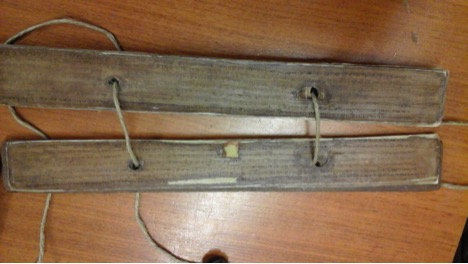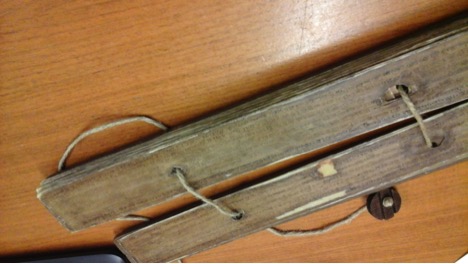Kristucaritram, ‘The Story of Christ’
The manuscript library in Tübingen is a treasure grove for researchers. Besides manuscripts related with German and European history and religions, the library has an impressive collection of Indian manuscripts including Malayalam paper and palm-leaf manuscripts brought from Kerala to Germany by the nineteenth-century scholar of Malayalam Rev. Hermann Gundert. The manuscripts from India are currently being scanned in a DFG-funded project of digitization. As an exception, in view of the collaboration between the two Universities, the head of the project ‘Gundert Portal’, Dr. Gabriele Zeller, led me into the Holy of Holies – the inner quarters of the manuscript library – for taking out manuscripts that may be of interest to our JewsEast project. My friend and colleague Dr. Elena Mucciarelli, a scholar of Sanskrit, Kannada and Malayalam who is currently employed in the digitization project, heartily shared with me her data and copies of manuscripts that are already scanned. And indeed, soon the archive in Tübingen yielded a palm-leaf manuscript catalogued as Ma I 845, with the title Kristucaritram, ‘The Story of Christ’, obviously a Christian composition. I spent some time with the manuscript for initial acquaintance, until it is scanned and available for an in-depth study. Gabriele and Elena promised to prioritize the digitization of Ma I 845. Hopefully, our South Indian team will soon be able to present an in-depth study of what seems to be a unique text.
The first eighteen verses of the narrative reveal interesting features of language, style and narration. Prof. Istvan Perczel, the JewsEast expert on Kerala Christians, is under the impression that the text is a gospel harmony composed on behalf of the early modern Catholic mission in Kerala. The first missionary that comes to mind in this regard is the German Jesuit missionary Johann Ernst Hanxleden (b. 1681), who lived in Kerala since he was 19 years old until his death in 1732. Hanxleden is known in Kerala as Arṇṇos Pātiri (Father Ernst) and celebrated for his Malayalam writing for promoting the Christian faith in the early eighteenth century. Hanxleden was also a Sanskrit scholar; he published the earliest Sanskrit grammar (in the Malayalam script) written by a European scholar, Grammatica Grandonica (Toon Van Hall and Cristophe Vielle (eds.), Potsdam 2013). But the palm-leaf manuscript that I have examined last week remains to be investigated before attributing its composition to a European missionary.
It is, however, quite clear that the text has names found in the Greek-Latin tradition of the gospels. It is also clear that the text is not a translation in the modern sense, such as initiated by Claudius Buchanan in the early nineteenth century. Istvan suspects that the Kristucaritram may be the first missionary endeavor to communicate the text of the gospels to the Malayali Christians. However, such adaptations of pan-Religious textual traditions into the regional language are typical of the “Vernacular Millennium”, as coined by Sheldon Pollock (Cosmopolitan and Vernacular in History, Public Culture 12(3): 591-625, 2000). It is only after a thorough examination of the manuscript that we are able to know better about the circumstances of the composition. After all, there may be a colophon hidden somewhere in the text.
The manuscript is written on waxed palm-leaves by a skilled scribal hand. The folios are numbered in the Malayalam numerals. It might very well contain other compositions as well. Fearing to damage the precious and rare item before it is digitized, I focused on the first pages to get acquainted with the text. Now, back home, I browse the secondary literature for clues. A composition by the name Kristucaritram is not listed among the writings of Arṇṇos Pātiri, as Hanxleden is known in Kerala (Arṇṇos Pātiriyuṭe Padya Kṛtikaḷ, Father S Termaṭham (ed.), Trissur, 1982). That, of course, does not rule out the possibility that a Jesuit missionary is the author. However, it is equally possible, at least ostensibly, that a native speaker of Malayalam is the author. The few lines which I have transcribed in Tübingen are insufficient for a decisive answer at the moment. Nevertheless, I can provide even at this early stage some details of interest.
The first folio is used as a cover page – it is not numbered and the ink is faded as it was not waxed rending the manuscript almost unreadable. But I could recognize that the scribe referred to someone born in Jerusalem (piṟanna yeṟuśalem nagarattil) before inserting a line in small letters that reads: hari śrī gaṇapataye nama avighna[m astu], “Salutations to the venerable God Gaṇapati, let there be no obstacles!” This statement is a conventional address by poets (or scribes) to Lord Gaṇapati, the remover of obstacles in the Hindu pantheon and the patron of the arts. The scribe must have been a professional trained in the traditional Malayalam education system of the premodern period. He might have been a Hindu scribe paid by a Christian; it is difficult to imagine that a European missionary will use this typical Hindu expression.
The first eighteen verses that I read so far are in a scholarly language typical of the Classical Malayalam style and abundant with Sanskrit words and forms. The style of narration employs filler words like aṅṅә and kaṉivoṭe that resemble epic style as in the Kṛṣṇagātha (ca. 15th century) or the Ᾱdhyātmarāmāyaṇa (ca. 16th century). The opening line, “God, help me in [composing] this! (atinnāyi tuṇacciṭuka veṇam)” is along the lines of poetic convention in Malayalam literature, perhaps the Christian equivalent of the opening formula addressing Gaṇapati. The text starts with a summary of John 1:1-18. It is then interrupted by an utterance in the voice of the composer, stating that he cut the story short (aṅṅiṉe akkathaye curukki ñāṉ). The text proceeds in a summary of Luke 1:26-38.
Remarkably, the composer uses two Sanskrit phrases – the first is bhumau, ‘upon the earth’, inflected according to the Sanskrit paradigm of nominal inflections (f.sg.loc) and the second is nâsti (neg-cop.prs.3sg) instead of the Malayalam illa (neg.exist). Such forms are remarkable as they resemble the hybrid Malayalam-Sanskrit maṇipravāvaḷam literature (Rich Freeman, 1998, “Rubies and Coral: The Lapidary Crafting of Language in Kerala” The Journal of Asian Studies 57(1):38-65).
The title of the work reads: “The Story of Christ”, with what is possibly a second heading: “The Birth of the Savior of the World (lokarakṣitāvә)”. Mary, the focal character, is described as an offspring of the house of David (dāvid-gotri-y-āyoru maṟiya) rather than Joseph, who is not mentioned in the eighteen verses transcribed so far. According to the medieval apocryphal tradition Mary was also descending from David, although there is absolutely no hint at this in the gospels.
It remains to transcribe and translate the scanned copy of the manuscript for more evidence of the relevance of the text to the study of Jewish-Christian relations in the Malayalam-speaking region in the premodern and early modern periods. The fact that the text is written on palm leaves rather than paper is suggestive of deep involvement in the local literary tradition of Kerala Christians. Therefore, the text may represent the attitude of Kerala Christians towards Jews when the influence of the Catholic missionaries was not yet all-pervading.
A rough translation of the first eighteen verses of the manuscripts is given below, with some of the terms in the original Malayalam in parentheses for demonstrating the lexical orientation of the text (Syriac, Latin, Sanskrit etc.). The phrases in brackets denote complements or unclear parts (marked by dots if too long to be complemented). I am indebted for Prof. Istvan Perczel and Rev. Dr. Ignatius Payyappilly for their comments on the rough transcription and translation of the first 18 verses. All mistakes are my own (Ophira Gamliel).
The Story of Christ: The Birth of the Savior of the World
In the beginning was the Word. This is that which is God.
All that was created is by Him alone. There is no creation at all without Him. […..
[…]was given to us according to God’s command (ājña) first by Moses (mośa); later truth and mercy (satyavum kṛpayum) were those things which were revealed by Jesus (yeśu). These are the things of substance (vastukkaḷ).
Even if [one cannot find] God, Christ (kirattu) who is the son of God had informed of the manners of God to all the people for the knowledge of salvation (mokṣaviddhya).
[….] After fighting for a long time, the Romans won and conquered the kingdom. At that time, the Roman emperor whose name is [….] made an Edomite (edomyaṉ) by the name Herod a king to rule over Judea (yahuda).
As this was going on, the son of God who is Christ incarnated (avatāram ceytu) in the dynasty of David for bringing bliss (maṅgalam) to the world.
Now I have shortened this story for annihilating the distress in [my] heart.
The Lord of the World (lokanāthaṉ) had dispatched the messenger Gabriel (gābriyel dūtaṉ) to Mary (maṟiya), an offspring of the dynasty (gotri) of David who was living in Nazareth (nasaṟattenna paṭṭaṇe). He went there and approached the Virgin Mary and told (connāṉ) her like this:
“Bless you, maiden, who is the receptacle for God’s compassion! [There is always] help in God for the suffering upon the earth. You are she who is graced by God! [Having heard these words], she was wondering, “what is this?”. Then the messenger of God said: “Mary, have no fear! […] You will conceive a son who will be called Jesus. He will then be known as the son of God. God will send him and he will give him the venerable royal throne of the father (guru) David in your family. There is no doubt about it! Thereafter, he will rule as the supreme king of the tribe of Jacob (yākkoba taṉ kule) forever.” When Mary heard this, she asked, “until now I have never known any man, not even a little bit. How is this [prophecy] going to happen?” Then the messenger said this, “Know it and have no doubts. The Holy Spirit (pariśuddhaṉ āyuḷḷor’ ātmā) will come to you. Not only that; the power (śakti) of the Almighty (? adhikānnataṉāyoṉ) will be reflected upon your body (niṉmeṉiyil… niȥalikkum) so that everyone will call the sacred form (pariśuddham āyuḷḷoru rūpam) that is born ‘Son of God’. Moreover, there is one more miracle I wish to tell you. Listen to me. Your relative Elizabeth (eliśabett) who is an old woman known to be barren is now six month pregnant. Know that there is nothing at all (onnume … nāsti) in this world that is unattainable by God.” Thus said Gabriel and then….





















